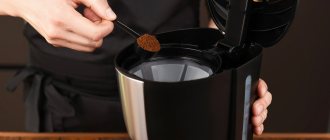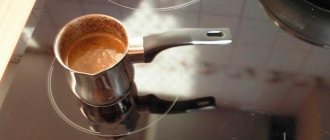As a die-hard coffee lover and home barista, you've definitely heard of siphon coffee makers. Coffee made in a siphon is unlikely to be inferior to anything, and its taste can be compared to coffee from the best baristas in the universe. In addition, making coffee in a siphon at home is now fashionable.
In order to make coffee in a siphon, you need to make an effort and behave carefully. The vacuum brewing process is very interesting and a lot of fun. We think it's time for you to embark on this adventure!
We thought you might find some helpful tips on how to choose these complex but beautiful coffee makers. Right?
That's what we thought.
That's why we wrote reviews of the 5 best siphons that are currently on the market. Before we jump straight into the reviews, let's talk a little more about siphon (or vacuum) coffee makers so that you're clear on what you're about to get into.
Enjoy your coffee!
There is always room for experimentation - try different grains, change the grind size, add clear juices - apple or cherry - to the water. Try adding coffee to the top flask immediately after raising a small amount of water, wait until the water has completely risen, remove the burner and place a few ice cubes or frozen fruit slices in the top flask to stop the brewing process.
Life hack: A siphon is also an excellent device for brewing not only coffee, but also tea; try brewing Pu-erh in it, and you will get an excellent tea drink.
Read our articles about how to make coffee in other coffee gadgets.
History of Gabet
In Western Europe, unlike Eastern Europe, love with a Turkish woman did not work out. From the 18th to the 19th centuries, European coffee lovers tried to come up with a device that would allow them to prepare aromatic and tasty coffee.
In the 30s of the 19th century, coffee makers, consisting of two spherical vessels connected by a tube, came into fashion. Water was poured into the lower container, a filter was placed at the bottom of the upper container and coffee was poured. The lower container was heated. When the water boiled and steam formed, under the pressure of which it was forced out of the lower vessel into the upper one, where the coffee was brewed.
After this, heating was stopped. As a result, a vacuum was created in the lower vessel, due to which the finished coffee from the upper container was sucked into the tube and flowed down. The lower vessel was equipped with a tap, with which it was easy to pour coffee into cups.
It is believed that the first person to come up with such a design was the Berlin inventor Loeff. History has not brought us images of the coffee maker he created. But in 1841, a certain Madame Vassier from Lyon patented a device that differs from modern siphon models only in the decorative crown crowning the upper ball (Fig. 1).
Fig.1. Coffee maker patented by Madame Vassier
The coffee in the siphon turned out excellent: aromatic and not overcooked, since the ground beans were in contact with hot water and not boiling water. Initially, candles and oil lamps were used to heat the lower ball, but it turned out that the best option was an alcohol burner.
Rules of circulation
Operating a coffee siphon is quite simple, but you still need to know some operating rules.
- The heating element does not cool down immediately, so it should be handled with care using oven mitts.
- It is not recommended to expose the siphon to constant heating for more than a certain time. Exposure to the flame should last for 10-15 minutes, then the device should be allowed to cool completely before using it again.
- The alcohol lamp or burner should be refilled with fuel in a ventilated area.
- Get a special stand for manipulating the siphon, preferably made of non-flammable material.
Popular models on the market and approximate cost
The most popular models are:
- The Japanese company Hario offers a wide range of coffee siphons. The advantage of designs from this company is their compactness. The average price of a device from such a company is 5000-7000 rubles.
- The electric siphon is designed specifically for those coffee lovers who do not want to bother with the burner. For such a model you will have to pay approximately 8,000 rubles.
- Retro-looking devices will be appreciated by true lovers of coffee and the history of the drink. Such designs look very picturesque. The approximate cost is 7000-9000 rubles.
Chinese manufacturers offer simple versions of siphons for 3000-4000 rubles. But such designs are only suitable for use at home.
"Coffee Show"
Despite the simple principle of operation of this device, more specifically the ability of gas to increase in size when pressure is applied to it, preparing an aromatic drink in a siphon for brewing coffee is a real show.
Not a circus, of course, but quite dynamic. Everything seethes, boils, flows back and forth through the tubes and ends in an impressive splash.
Bottom line
Coffee from a siphon really turns out to be unusual and quite tasty; the process itself will appeal to both true coffee connoisseurs and beginners.
By volume: for personal use, I advise you to take gabettes with a small volume of ≈300 ml. For large companies, accordingly, gadgets with a volume of 600 ml or more are more suitable.
Device
A burner operating on alcohol liquid was located at the bottom of the chassis. He held his body, as well as a small basket for spoons. The train body included two sections:
- ground coffee drink was placed in the first part of the device,
- liquid was poured into another compartment located behind.
The two compartments are connected to each other using a tube. Filter material was placed at the end of the tube. The cavity of the rear compartment included a lever control. The work was carried out according to the following principle: water went through a tube into the first chamber, another mechanism rose higher, closing the lid of the alcohol lamp
Subtleties of cooking
Using a siphon does not cause any difficulties. The main thing is to adhere to the following recommendations when using it:
- fill the lower tank with water to the special mark, and not completely;
- For every 100 ml of liquid, use 2 teaspoons of coffee powder;
- Use heated water to make coffee. Due to this, brewing will require significantly less time;
- The drink should be poured into cups immediately upon completion of preparation. This is due to the fact that the glass container cools quickly;
- Grinding coffee is not of fundamental importance. The main thing to consider is that the larger the fractions, the more time it will take to brew;
- Gas burners are easier to use than alcohol burners.
Invention of the balancing siphon
The process of brewing coffee in a Vassier siphon looked very impressive, and therefore soon such devices began to be placed on the table. But it turned out that the lower ball was too fragile: as soon as the housewife was careless and did not turn off the burner in time, the glass would burst or even explode. Heat-resistant glass had not yet been invented at that time.
It was urgently necessary to come up with a way to automatically turn off the burner. The best design was patented in 1844 by the Frenchman Louis Gabet. His coffee siphon consisted of two communicating vessels: ceramic and glass, mounted on a balancer lever (Fig. 2). They were connected to each other by a tube.
Water was poured into a ceramic container, and coffee was poured into a glass container. Under the ceramic vessel there was an alcohol burner, the lid of which was attached to its bottom. When heated, the steam forced the hot water into the glass vessel and, as the ceramic vessel became lighter, it rose upward, causing the burner lid to close and the heating to stop. As the steam cooled, a vacuum formed in the ceramic vessel, and the brewed coffee was sucked out of the glass container through the tube.
Fig.2. 19th century balance siphon
The Gabet siphon is also called the balanced siphon, the Viennese siphon (the device was especially popular in Austria) or simply the Gabet siphon. In the best traditions of the Victorian era, ceramic vessels were decorated with pastoral images. In the mid-19th century, balance siphons replaced coffee makers made of two glass balls.
The model created by Jean Baptiste Toselli in the 60s of the 19th century is rightfully considered the pinnacle of skill in the manufacture of Viennese siphons (Fig. 3). This coffee maker was a 40 cm long replica of a steam locomotive made of porcelain.
The bottom of the gold-plated brass chassis houses an alcohol burner. The chassis supports the locomotive's porcelain body and a basket for teaspoons and sugar. The body is divided into 2 compartments: ground coffee was placed in the front one, water was poured into the back one. The compartments are connected by a tube ending in a filter. There is a lever mechanism under the rear compartment. When water flows through the tube into the first compartment, the second rises and closes the burner lid.
Fig.3. "Coffee Locomotive" by Toselli
Please note before purchasing...
So, you have read the reviews of the best siphon coffee makers available in the market. Let's see what other useful things you need to know about the device and the process itself.
Is the coffee maker freestanding or stovetop?
Siphons can be used both autonomously and on a stove. The quality of the coffee does not depend on this.
A stand-alone siphon coffee maker prepares coffee using a built-in or separate burner, which is located under the lower chamber. The burner can be either alcohol or gas.
There is another type of siphon coffee makers that operate on an electric or gas stove. Keep in mind that you will need to place a diffuser between the device and the heating element. Direct contact with heat can increase the likelihood that cracks will develop in the lower chamber.
We prefer freestanding siphons that look vintage and meticulously detailed. True, such devices are slightly more expensive than simpler models that work on the stove.
Materials
Preparing coffee using the siphon method has been used since the 1830s. At that time, devices were made of brass and stainless steel. Such models can still be found. True, now they will rather play the role of decor, paying tribute to the old times. Such devices are unlikely to be practical.
Nowadays, the bodies of the best, high-quality siphons are made of heat-resistant borosilicate glass. This, of course, does not mean that the devices become indestructible. If you take care of them carefully, they will last you a very long time.
Filters
Most siphon coffee makers use fabric filters, which are great for sifting out coffee particles. However, such filters are difficult to clean. If you don't want to bother, choose a model with a stainless steel filter. Cleaning these filters is very simple.
What about burners?
If you decide to purchase a stand-alone coffee maker, then it should come with a burner. Different burners are combined with different models of siphons.
The most commonly used burners are butane, gas and alcohol burners. Newer machines may use electric or halogen burners.
The alcohol burner is the cheapest. However, you may find it difficult to control the temperature until you get the hang of it. You may also find that there will be a lot of soot left at the bottom of the siphon.
We prefer gas or butane torches. They are usually quite reliable. They are easier to use and control than alcohol burners and will not leave soot marks.
How many servings of coffee do you want to make?
Like many other systems, siphons can produce different amounts of coffee. Usually you can prepare from 3 to 8 mugs at a time. Don't forget to check the coffee maker's capacity before purchasing to make sure it suits your coffee consumption level.
Principle of operation
From the above information we can conclude that the device of the gadget is quite simple and understandable. Knowing it, it is easier to understand what the operating principle of the device is. Let's take a closer look at how such a device works using the example of a tea siphon.
First of all, before starting to operate this device, you always need to check the reliability of its design. The filter must be firmly attached to the upper container using a spring. The latter, in a state of tension, is fixed using a special hook that follows from the edge of the connecting tube.
Such a device operates on the principle of gas expansion under heating conditions. Pour hot water into one of the containers. As for the second one, which connects to the first special glass tube, you need to pour tea leaves into it. The liquid in the container located below heats up and bubbles, gradually rising to the container located above. Boiling (not to be confused with boiling) allows the liquid to achieve sufficient oxygen saturation, which has a beneficial effect on the taste and aroma of the drink. Everything usually takes about 30 seconds or 1 minute. By changing the power of the burner, it becomes possible to regulate the force of seething.
A drink, for example tea, can be stirred gently using a wooden stick. To do this, just remove the cap. As soon as the tea is ready, the burner must be turned off and put back in its place. Remove the plastic cap from the flask on top. The drink descends accompanied by a characteristic fizzing sound.
After all the above steps, it is permissible to proceed to disassembling the device. Flasks must be removed only while wearing gloves. The container is removed from the top and carefully placed on the inverted lid.
It is not recommended to throw away the tea leaves. It is better to brew it again. From the container located below, tea will need to be poured into bowls or poured into an intermediate teapot. This way you can cool the drink and let it stir well. The complete cooking process rarely takes more than 10 minutes.











